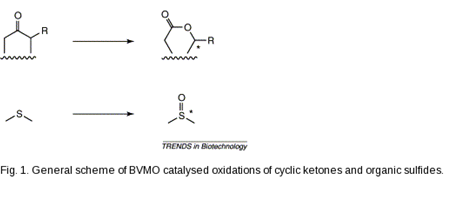Baeyer-Villiger monooxygenases
These flavin monooxygenases which catalyze the Baeyer-Villiger oxidation reactions, represent an efficient procedure for the production of optically active lactones. In fact, these enzymes are capable of converting not only aliphatic ketones to esters, but in particular, the conversion of cyclic ketones into chiral lactones. These chiral synthons have important applications in asymetric chemistry.

While the number of available Baeyer-villiger monooxygenases has grown significantly over the last few years, there is still a need for novel BVMOs in order to enlarge the scope of substrates or offer enantio-complementarity.
In order to contribute to this issue, we explored enzyme biodiversity in prokaryotic strains. Finally cloning of 143 putative BVMO genes, representative of biodiversity gave access to 73 enzymes experimentally validated as BVMOs and previously annotated as monooxygenases. Substrate profiling (20 compounds) was performed and the characterization of stereo- and enantio- selectivity of these new BV is in progress in collaborators' lab. From those, two BVMOs catalysing the regio-complementary BV oxidations of cycloalkenones have been found and characterized. However side-reactions during whole-cell biotransformation impeded access to unsaturated lactones in high yields.
To abolish theses side products formation, the E. coli reductase was identify and inactivated by mutation increasing the yield from 40 to 80% (Alphand et al., in prep). Several BVs were also identified to catalyse methyl ester compounds from linear short and large ketones that cannot be done usually by chemistry synthesis (Regnier et al., in prep). Evolution study of the Baeyer-villiger monooxygenases enzyme family was also done revealing the functional importance of highly conserved residues.